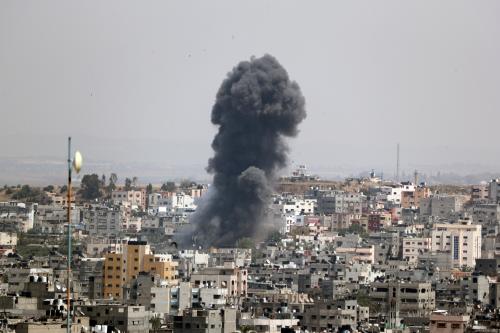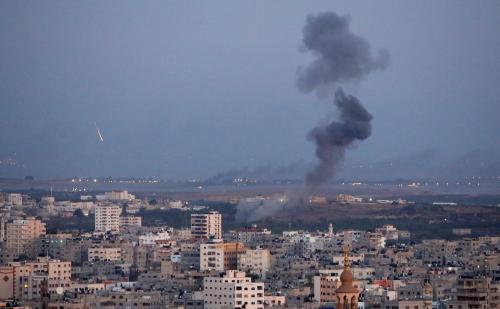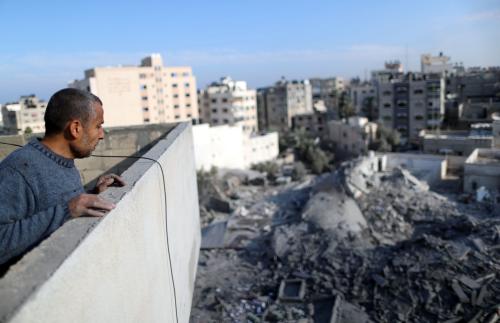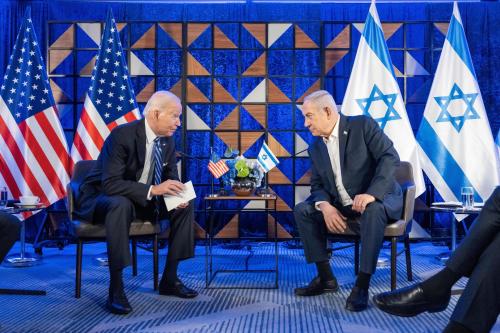While events in the Middle East often surprise, the latest exchange of blows between Israel and Gaza in early May came as no surprise to most people who read the news. It was the eighth such round in the last year, with some rounds only lasting a day.
Still, the most recent events shed a different light on several strategic and tactical aspects of the ongoing conflict with Gaza (and Hamas) that are worth focusing on. In short, this round was different.
What brought us here?
Beyond the broad, protracted issues at the heart of the Gaza conflict, the precipitating factor here was a set of extended demands that Hamas forwarded to Israel through the Egyptian delegation in Cairo in April. They included demands to double the salaries of Hamas’s civil servants, to extend the humanitarian aid to longer-term economic projects in Gaza, and to widen the zone where the Israeli Defense Force (IDF) permits Palestinians to fish off the Gaza shore. All of these were measures the Israeli leadership was attempting to put off.
The Israeli government walks a tightrope in these negotiations, juggling several goals at once—not always successfully. First, it seeks to prevent a humanitarian crisis in Gaza. Second, Israel aims to keep Hamas weak militarily and maintain its image as failing to govern effectively in Gaza. Finally, Israel wants to decrease the number of casualties and damage inflicted during recurrent popular protests on both sides of the border fence. These goals sometimes come to conflict, as Israeli leaders want to provide funding for the people of Gaza without funding the entity that controls them. Israel further wants to avoid the appearance of conducting dialogue with or providing incentives to an organization that uses violence to achieve its aims. Facing this labyrinth of interests, Israel reluctantly sees these indirect negotiations with Hamas as a “necessary evil.”
Yehya Sinwar, Hamas’ chief in Gaza, understands the vulnerability of Israeli public opinion. After all, Sinwar spent almost 20 years in Israeli jails, speaks Hebrew fluently, and during his time behind bars was known to be an avid consumer of Israeli political literature. Sinwar has also learned to skillfully master the ultimate “weapon of the weak” by leveraging collateral damage to fuel domestic and international support.
In many respects, this escalation came at a good time for Sinwar. With Israeli Memorial Day and the 71st independence celebrations upcoming, Israel’s public attention had drifted elsewhere and was therefore easier to exploit. In addition, the Eurovision singing contest that is taking place in Tel Aviv provided a real opportunity to rain on the parade and inflict a major blow to Israel’s image and economy.
The May conflict was the most violent on the Israeli side since the summer of 2014, when a 50-day, all-out campaign took place. This time, Israel suffered 4 civilian casualties and over 150 injured. Israel attacked about 320 targets, which resulted in at least 25 dead in Gaza. Hamas and other groups fired about 700 rockets into Israel on May 4 alone—for comparison, in 2014 they fired fewer than 200 rockets per day.
The tactical level
On the tactical level, Hamas fell short of achieving the damage it intended to inflict. More than 70% of its rocket launches fell in open fields, scattered nowhere near populated areas. Most of the other rockets were effectively intercepted by Iron Dome technology. Additionally, they failed in their attempts to launch the improvised, short-range, high-payload mortars that were perfected during the Syrian civil war and that the IDF nicknamed Ra’am (“thunder”). While these mortars are designed to inflict devastating damage to the Israeli population periphery around Gaza, the launches instead landed near the border, on Gazan soil. This created deep frustration on the Palestinian side and evidently affected their motivation to end the conflict.
Even with these failures, the damage inflicted on Israel was a jolt to the Israeli public. On the tactical level, Hamas and the Palestinian Islamic Jihad (PIJ) tried a new tactic. They aimed several launches simultaneously at the same Iron Dome battery in an attempt to overwhelm its defense capabilities with several short-range rockets. If one rocket could slip through the shield, it would suffice for the goals of Hamas and PIJ. This explains the damage and casualties on the Israeli side. The lesson to be learned is that no technology can provide an impervious solution. Israeli leaders should consider a more proactive approach to counter the launches, on the one hand, and work to reach a long-term political solution, on the other.
Israel in many ways took the gloves off, but managed to do so in a surgical manner. Air attacks were comprehensive, engaging many targets simultaneously. Targets were chosen carefully with the intention of weakening Hamas’s military installations and command-and-control posts. So-called “power targets” that constitute headquarters, command posts, and military installments disguised in multi-story buildings in the heart of Gaza were targeted systematically. Local inhabitants were forewarned, in what the IDF calls a “knock on the roof,” a delicate phrase for launching a small rocket on the roof of a house that is about to be targeted in order to signal to its inhabitants that they should evacuate immediately. Additionally, contrary to previous rounds, Israel targeted the homes of military figures without causing physical damage to their family members. The damage and cost were very personal, since top terrorist commanders are now homeless during Ramadan.
Israel targeted and killed Hamed El-Khoudari, a lead figure in Hamas’ financial network. The elimination of El-Khoudari, a mid-level activist, is important in limiting the flow of funds to Hamas and PIJ, but most of all it sends a message to the leading figures that some old tactics are back in play and that the rules of engagement are about to change. Israel had not conducted targeted killings for more than six years. While the effectiveness of the practice is debated, some studies emphasize its deterrence effect and ability to disrupt terrorist command-and-control. There is a saying that when your adversary’s gaze is fixed on the sky, they make different decisions on the ground—this captures the rationale behind targeted killings.
The strategic level
On the strategic level, the latest round of violence underscores the impact that smaller players—namely the PIJ—have in this arena.
Recently, the PIJ and its new leader, Ziad Nahala, decided to undermine the ongoing deliberations in Cairo between the Egyptian security authorities and Hamas. While these talks are aimed at achieving a more sustainable status-quo in the region, and promoting a so-called hudna (i.e. truce, armistice) with Israel, the PIJ had its mind set on carrying out an attack—the sooner, the better. After several failed attacks, it carried out a sniper operation on May 3 that wounded two Israeli soldiers. Israel reacted, and the PIJ got its way by practically dragging Hamas into the turmoil. Hamas would not have taken the initiative to start this round, but quickly realized the potential gains in light of Israel’s mindset post-elections, with Netanyahu concentrating on coalition negotiations and with Israeli Independence festivities around the corner.
In this sense, Israel has failed in pressuring Hamas to force their hand on PIJ, a relatively small organization that is heavily supported by Iran. PIJ leaders proved to have a mind of their own, difficult to control and quick on the trigger. The presence of PIJ activists on the ground and their ability to drag all sides beyond fragile “understandings” and into a new war game is a major concern for the future. As Elior Levi, an Israeli analyst has written: “PIJ made it to the big league and now earned a permanent seat in Cairo’s negotiations roundtable.”
It appears that Israel has achieved at least one major goal during this last round: deterrence. The key here isn’t the damage statistics and casualty numbers, but rather the reaction on the Palestinian side. The rising pressure on the coalition of organizations in Gaza has prompted them to push fervently for a ceasefire, which Israel rejected several times. Israel managed to revive its deterrence of Hamas, and this might delay the next exchange of blows, perhaps toward the end of this summer.
Moreover, Israel was able to inflict major damage to its infrastructure and target leading figures and their possessions without losing international legitimacy and without political consequences. Of course, deterrence is an eroding commodity and will wear out soon enough. Still, Israel controlled the escalation, and Hamas failed on most tactical fronts to catch Israel’s defense maneuvers off guard. Israel stepped into this conflict with a large bank of targets, solid intelligence, a measured and accurate deployment of munitions, and a more aggressive targeting policy—which proved effective, for now. Hamas will have to think twice—in the near term, at least—before they send the Palestinian masses to ignite the border fence.
Finally, after the ceasefire, Hamas and the PIJ are in no better position than they were on May 3, at the outbreak of this round of conflict. This is a testament to the manner in which Israel controlled the escalation, with Sinwar and Nahala unable to advance their position in any immediate way.
The collision of strategy and tactics
At the moment, Israel’s strategy aims low: to keep Hamas and the PIJ weak and deterred. It seeks to achieve this end by depriving these organizations, steadily but surely, from all their strategic operational assets.
In the long run, this strategy might lead to a range of potential outcomes. At one end, it could produce—in conjunction with wider diplomatic efforts—a more pragmatic Hamas that can be negotiated into a long-term hudna. At the other end lies a crisis involving a full-fledged Israeli military intervention in Gaza to topple Hamas and to seek to pave the way for a return of the Palestinian Authority. More likely than either of these extremes, however, is a continuation of this chronic state of friction and the intermittent exchange of blows.
This last round of fighting, and the deliberations on the Israeli side, underscores two major tensions between the tactical level and the strategic level that are unbridgeable.
First, the Israeli security forces and the IDF realize that if they are to walk into an all-out confrontation with Hamas and the PIJ in Gaza, then it must be on their terms, with the element of surprise on their side. Israel has to engage Gaza out of the blue, striking pre-emptively, if it wants a short, decisive, and successful military incursion. The blueprints for such a plan are undoubtedly ready, and yet they may never see the light of day.
The international repercussions of a seemingly unprovoked, full-fledged military campaign will place a heavy price on other Israeli interests. Israel, due to political considerations, must be sucked into a provoked conflict and forced to react—this is how it sustains its legitimacy and makes use of its full arsenal of capabilities while avoiding political repercussions from the international and Arab community. Stepping into a conflict like the one we just witnessed, with ground forces, would play into Hamas’ hands and tactics. The casualty toll will be too big for the IDF, public support will diminish quickly, civilian casualties will increase as forces struggle, and international rebuke will spike quickly. The campaign will have to stop short—like what happened in the summer of 2014.
Second, when a round of conflict erupts and internal and public debates rage in Israel over military retaliation, the so-called “adults in the room” raise the second strategic dilemma. If Hamas were to be toppled by military force, the question remains of what happens afterward. Who will take charge of the two million people in the Gaza strip? Is there an alternative authority that can take the reins and guide the process to a peaceful resolution?
The United States long struggled with the issue of governance and state-building in Iraq and Afghanistan, and the lesson is that military campaigns are often only the beginning of long-term, intractable challenges.
The Palestinian Authority in the West Bank has been physically disconnected from Gaza since 2007 and politically separated, to a degree, since even before then. For many young people—who have grown up with the violence of the Second Intifada, the intra-Palestinian clashes and Hamas takeover of 2006-07, and the ongoing clashes with Israel—there is no other reality. A large part of Gaza’s population, namely the civil service, has been dependent on Hamas’ way of operating. In many ways, the demographic, political, and ideological circumstances in the Strip have created a situation in which Hamas’ modus operandi would remain potent even if it were to lose control of Gaza.
Israel has no intentions to reoccupy Gaza with its own troops and take responsibility for its two million inhabitants. Netanyahu realizes that winning the military campaign can only amount to a bitter victory that Israel cannot endure.








Commentary
What we can learn from yet another round of conflict in Gaza
May 16, 2019